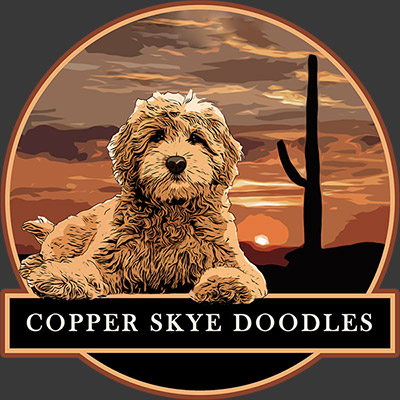Hypoallergenic Goldendoodles
Hypoallergenic Goldendoodles
You may have heard hypoallergenic Goldendoodles are an ideal pet to consider. This is especially true if you are a dog lover with allergies, or someone with family and friends who have allergies. The reality is there are no completely hypoallergenic dogs. However, dogs that are low shedding and produce minimal dander are the best fit for those who suffer from allergies. You don’t have to give up the search for a furry friend!
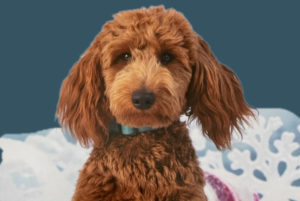
The more hypoallergenic Goldendoodles are a cross between a Poodle and a Golden Retriever, with a greater percentage of Poodle genes that result in low shedding. Goldendoodles with more influence from the Golden Retriever genetics, tend to shed more fur and release more dander into their living environment. At Copper Skye Doodles, we aim to breed Goldendoodles with the most suitable coats for those with allergies.
You may have heard hypoallergenic Goldendoodles are an ideal pet to consider. This is especially true if you are a dog lover with allergies, or someone with family and friends who have allergies. The reality is there are no completely hypoallergenic dogs. However, dogs that are low shedding and produce minimal dander are the best fit for those who suffer from allergies. You don’t have to give up the search for a furry friend!
The more hypoallergenic Goldendoodles are a cross between a Poodle and a Golden Retriever, with a greater percentage of Poodle genes that result in low shedding. Goldendoodles with more influence from the Golden Retriever genetics, tend to shed more fur and release more dander into their living environment. At Copper Skye Doodles, we aim to breed Goldendoodles with the most suitable coats for those with allergies.

Allergies and Hypoallergenic Goldendoodles
There are a variety of allergies, and it’s important to identify which specific allergens trigger responses for you or your loved ones. Most allergic reactions to dogs occur in response to the saliva, dander or dead skin cells, and urine. Few people are actually allergic to dog hair, it’s the dander or saliva that tend to cause reactions. Hypoallergenic Goldendoodles are less likely to aggravate allergies, because their curly coat prevents the dander from being released as often.
Hypoallergenic Goldendoodles are often given this label because they cause fewer or less severe allergic reactions. When compared to dogs that shed more frequently and in larger quantities, Goldendoodles stand out. Less dander is released into the air and living space, with less shedding.
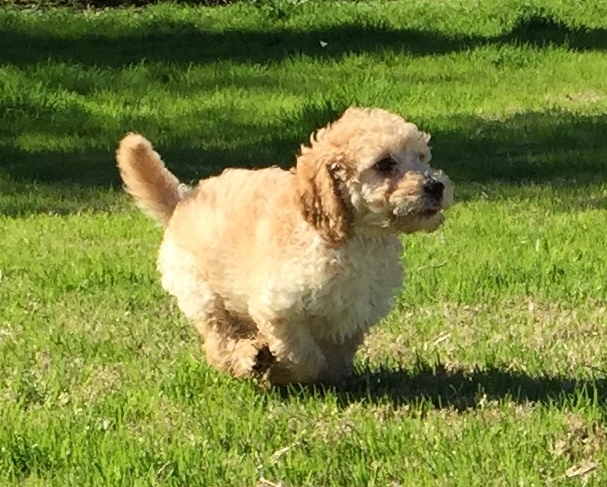
Some people are only allergic to pollen or other allergens in the air that may cling to a dog’s coat. Proper grooming and maintaining a shorter coat can help alleviate these issues. Those with mild allergies around dogs tend to notice their allergies are not triggered by more hypoallergenic Goldendoodles. You may need to vacuum, dust or clean more frequently, when the release of skin cells or dander is likely. While hypoallergenic Goldendoodles cause less of an allergic reaction, it’s important to understand that some Goldendoodles are more or less hypoallergenic than other dogs of the same breed.
Allergies and Hypoallergenic Goldendoodles
There are a variety of allergies, and it’s important to identify which specific allergens trigger responses for you or your loved ones. Most allergic reactions to dogs occur in response to the saliva, dander or dead skin cells, and urine. Few people are actually allergic to dog hair, it’s the dander or saliva that tend to cause reactions. Hypoallergenic Goldendoodles are less likely to aggravate allergies, because their curly coat prevents the dander from being released as often.
Hypoallergenic Goldendoodles are 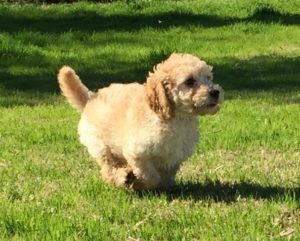
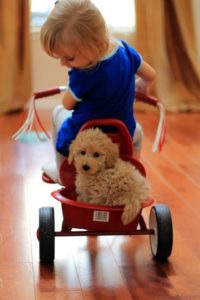
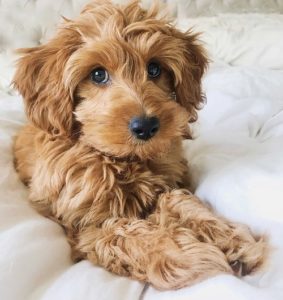 great fit often given this label because they cause fewer or less severe allergic reactions. When compared to dogs that shed more frequently and in larger quantities, Goldendoodles stand out. Less dander is released into the air and living space, with less shedding.
great fit often given this label because they cause fewer or less severe allergic reactions. When compared to dogs that shed more frequently and in larger quantities, Goldendoodles stand out. Less dander is released into the air and living space, with less shedding.
Some people are only allergic to pollen or other allergens in the air that may cling to a dog’s coat. Proper grooming and maintaining a shorter coat can help alleviate these issues. Those with mild allergies around dogs tend to notice their allergies are not triggered by more hypoallergenic Goldendoodles. You may need to vacuum, dust or clean more frequently, when the release of skin cells or dander is likely. While hypoallergenic Goldendoodles cause less of an allergic reaction, it’s important to understand that some Goldendoodles are more or less hypoallergenic than other dogs of the same breed.
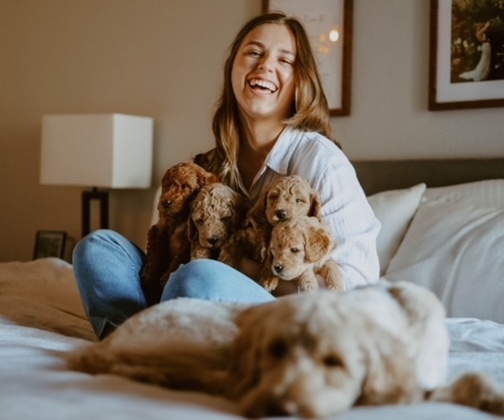
Poodle Genes and Hypoallergenic Goldendoodles
There is a range of variety in the hybrid breed of a Goldendoodle. A few factors impact how hypoallergenic Goldendoodles tend to be:
- Genetic makeup
- Generation
- Coat type/shedding
Poodles have a single, curly coat and only shed very lightly. If a Goldendoodle inherits more poodle genes, they are less likely to irritate allergies. The generation plays a role as well, since this determines a consistent history of curlier hair and low shedding. The letter B at the end of a generation, meaning Backcross, is a term for breeding the current Goldendoodle generation back to a purebred Poodle, thus giving more Poodle traits with less likelihood of shedding.
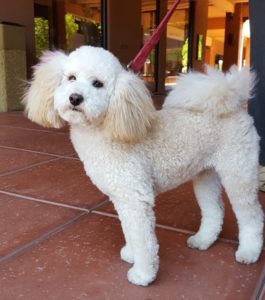
F1B and F1BB tend to be the most hypoallergenic Goldendoodle generations:
- F1B Goldendoodles are the first-generation (F1) offspring of a Goldendoodle and a Poodle. This generation produces more hypoallergenic Goldendoodles because they are 75% Poodle and only 25% Golden Retrievers. The F1B generation is a safer option for people who suffer from allergies, as an alternative to an F1 Goldendoodle.
- F1BB Goldendoodles are a cross between a Poodle and an F1B Goldendoodle. This generation is 85% Poodle and 15% Golden Retriever. These percentages produce the most hypoallergenic Goldendoodles and are the lowest risk option for those with allergies.
- If you have allergies, I recommend avoiding an F1 or F2 Goldendoodles, since these dogs are 50% Poodle and 50% Golden Retriever. These generations shed in larger quantities and more frequently, because they tend to have straighter hair that releases more dander.
I’m always happy to speak with you in detail about my most hypoallergenic Goldendoodles. I am knowledgeable about the family medical history of each parent—covering coat types, any health concerns, including dandruff or skin allergies. We can discuss the likelihood of your Goldendoodle expressing specific genes, according to their generation and family background.


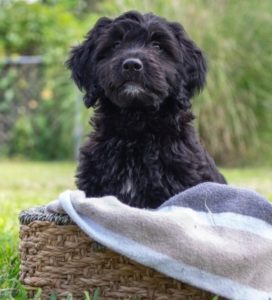
Poodle Genes and Hypoallergenic Goldendoodles
There is a range of variety in the hybrid breed of a Goldendoodle. A few factors impact how hypoallergenic Goldendoodles tend to be:
- Genetic makeup
- Generation
- Coat type/shedding
Poodles have a single, curly coat and only shed very lightly. If a Goldendoodle inherits more poodle genes, they are less likely to irritate allergies. The generation plays a role as well, since this determines a consistent history of curlier hair and low shedding. The letter B at the end of a generation, meaning Backcross, is a term for breeding the current Goldendoodle generation back to a purebred Poodle, thus giving more Poodle traits with less likelihood of shedding.
F1B and F1BB tend to be the most hypoallergenic Goldendoodle generations:
- F1B Goldendoodles are the first-generation (F1) offspring of a Goldendoodle and a Poodle. This generation produces more hypoallergenic Goldendoodles because they are 75% Poodle and only 25% Golden Retrievers. The F1B generation is a safer option for people who suffer from allergies, as an alternative to an F1 Goldendoodle.
- F1BB Goldendoodles are a cross between a Poodle and an F1B Goldendoodle. This generation is 85% Poodle and 15% Golden Retriever. These percentages produce the most hypoallergenic Goldendoodles and are the lowest risk option for those with allergies.
- If you have allergies, I recommend avoiding an F1 or F2 Goldendoodles, since these dogs are 50% Poodle and 50% Golden Retriever. These generations shed in larger quantities and more frequently, because they tend to have straighter hair that releases more dander.
I’m always happy to speak with you in detail about my most hypoallergenic Goldendoodles. I am knowledgeable about the family medical history of each parent—covering coat types, any health concerns, including dandruff or skin allergies. We can discuss the likelihood of your Goldendoodle expressing specific genes, according to their generation and family background.
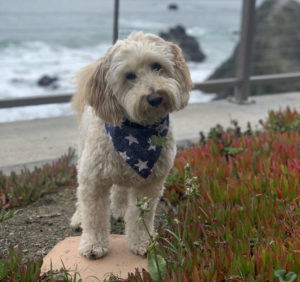
Goldendoodle Shedding and Curly Coats
Goldendoodles inherit curlier coats from their Poodle genes. These curly coats hold dander differently than looser wavy or straight hair. Dander tends to be held closer in the roots of the fur by the curls, preventing its release and resulting in a more hypoallergenic Goldendoodle.
Around 6 months of age, Goldendoodle puppies will start to shed their puppy coat. As this process begins, they can shed between three times a week and twice a day. As they grow, they shed less frequently, and sometimes the shedding is no longer noticeable in the most hypoallergenic Goldendoodles.





Goldendoodle Shedding and Curly Coats
Goldendoodles inherit curlier coats from their Poodle genes. These curly coats hold dander differently than looser wavy or straight hair. Dander tends to be held closer in the roots of the fur by the curls, preventing its release and resulting in a more hypoallergenic Goldendoodle.
Around 6 months of age, Goldendoodle puppies will start to shed their puppy coat. As this process begins, they can shed between three times a week and twice a day. As they grow, they shed less frequently, and sometimes the shedding is no longer noticeable in the most hypoallergenic Goldendoodles.

Hypoallergenic Goldendoodles and Reducing Allergen Exposure
There are steps you can take to reduce your exposure to allergens, in addition to choosing a more hypoallergenic Goldendoodle. These preventative steps will help limit allergic reactions:
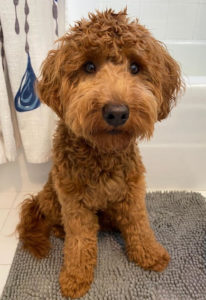
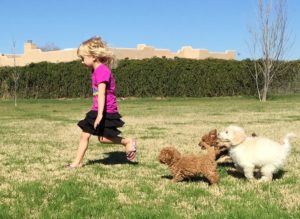
- Brush your Goldendoodle on a regular basis.
- Give your pup a bath once or twice a month.
- Plan to clean your home.
- Choose high quality food for your Goldendoodle
Brushing your Goldendoodle daily helps spread out the oils on the skin evenly, to keep dander levels lower. More hypoallergenic Goldendoodles will still benefit from regular brushing, since it also prevents matting in their coat. Scheduling regular grooming outside of your home every 6-8 weeks outside of your home will further reduce your exposure. Keeping hair short and maintained reduces surface area available for dust, dirt, and pollen. It will be easier to wipe or rinse clean your Goldendoodle, after a romp outside.
Scheduling a bath for your Goldendoodle once or twice a month will significantly reduce the amount of dander hanging out in their coat. Bathing too often can strip the skin of its natural oil, trigger skin sensitivities, and lead to more dander production. Select a shed control cleanser and a shampoo that keeps their skin moisturized. Dry skin is more likely to become irritated and chafe, producing additional dander.
Adding a few extra steps to cleaning your home can greatly reduce allergy flare ups, particularly during higher shedding seasons. Dusting or vacuuming around a half hour after brushing will eliminate any excess dander that escapes and settles in a living area. Avoid using carpets that hide allergens. Make sure to keep even hypoallergenic Goldendoodles’ toys and bed clean. Washing these items routinely will prevent dander and saliva accumulation.
Excellent nutrition is another important factor for your Goldendoodle. Selecting foods with Omega 3 and Omega 6 fatty acids can prevent dry, irritated skin and improve your pup’s coat. Liquid supplements or vitamins can be mixed with your dog’s food, but tablets and chews are also available. Feeding your hypoallergenic Goldendoodle a high-quality, balanced and nutritious diet is important to maintain your dog’s skin health.
Hypoallergenic Goldendoodles and Reducing Allergen Exposure
There are steps you can take to reduce your exposure to allergens, in addition to choosing a more hypoallergenic Goldendoodle. These preventative steps will help limit allergic reactions:
Brush your Goldendoodle on a regular basis.
Give your pup a bath once or twice a month.
Plan to clean your home.
Choose high quality food for your Goldendoodle.
Brushing your Goldendoodle daily helps spread out the oils on the skin evenly, to keep dander levels lower. More hypoallergenic Goldendoodles will still benefit from regular brushing, since it also prevents matting in their coat. Scheduling regular grooming outside of your home every 6-8 weeks outside of your home will further reduce your exposure. Keeping hair short and maintained reduces surface area available for dust, dirt, and pollen. It will be easier to wipe or rinse clean your Goldendoodle, after a romp outside.
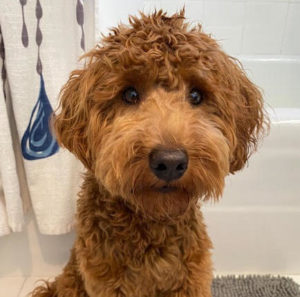
Scheduling a bath for your Goldendoodle once or twice a month will significantly reduce the amount of dander hanging out in their coat. Bathing too often can strip the skin of its natural oil, trigger skin sensitivities, and lead to more dander production. Select a shed control cleanser and a shampoo that keeps their skin moisturized. Dry skin is more likely to become irritated and chafe, producing additional dander.
Adding a few extra steps to cleaning your home can greatly reduce allergy flare ups, particularly during higher shedding seasons. Dusting or vacuuming around a half hour after brushing will eliminate any excess dander that escapes and settles in a living area. Avoid using carpets that hide allergens. Make sure to keep even hypoallergenic Goldendoodles’ toys and bed clean. Washing these items routinely will prevent dander and saliva accumulation.
Excellent nutrition is another important factor for your Goldendoodle. Selecting foods with Omega 3 and Omega 6 fatty acids can prevent dry, irritated skin and improve your pup’s coat. Liquid supplements or vitamins can be mixed with your dog’s food, but tablets and chews are also available. Feeding your hypoallergenic Goldendoodle a high-quality, balanced and nutritious diet is important to maintain your dog’s skin health.
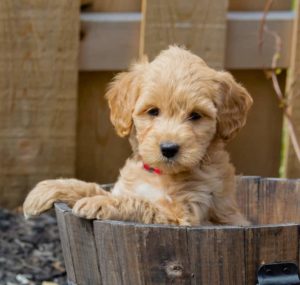




Adoption and Hypoallergenic Goldendoodles
At Copper Skye Doodles, I want to share the joy a Goldendoodle can bring you and your family. I’d be happy to talk with you openly about the medical history of your pup’s parents, the probability of a curlier coat, and genetic background of my most allergy friendly Goldendoodles. I can also share about experiences of other families who deal with allergies and have been happy with their adoption of a more hypoallergenic Goldendoodle. These pups are intelligent and adoring, some of the most loving dogs you’ll ever meet. Their gentle nature and abounding patience makes them great companions and family dogs.
I have more than 20 years of experience breeding and loving Goldendoodles and I’d be happy to meet with you in person or over the phone to discuss your hopes and questions. Copper Skye Doodles has an outstanding reputation and has placed hundreds of Goldendoodles into loving homes. I’m happy to take the time to share more with you and learn about which Goldendoodle would fill your heart and home with affection and companionship.
Frequently Asked Questions
Goldendoodles are an intelligent and obedient family companion. They are everybody’s friend and devoted to their family. They are friendly towards children, other dogs and pets, and easy with strangers. They are social dogs, happiest when with people. Goldendoodles are likely to get into mischief and develop behavior problems if they spend most of their lives alone. Their intelligence, eagerness to please, and love of learning make them very easy to train.
Yes. As a hybrid cross, Goldendoodles will inherit fur that looks retriever-like, or poodle-like, but usually something in-between. Unclipped Goldendoodles will have hair about 4-7 inches long, shorter on the face and longer on the body, tail and legs. Without grooming, painful mats can form and your adorable pup will look neglected and unkempt. Expect to thoroughly comb or brush your Goldendoodle regularly (all the way down to the skin). A curly coat will require more brushing than a straight or wavy one. Head to a professional groomer every six to eight weeks or so.
Goldendoodles are energetic, active dogs. Of course, some will be more active than others, but like all dogs, if not given moderate amount of exercise each day, they can easily get into trouble. Plan on your Goldendoodle needing at least two 30-minute periods of exercise per day. This can be accomplished through various means, such as brisk walks, jogging, hiking, swimming, agility work, or just good old-fashioned backyard playtime. Although exercise is needed, they can easily adapt to a life in the city or on a farm or anything in between.
With a name like Goldendoodle, one might think that gold is the only color they come in, but nothing could be further from the truth! Goldendoodles come in a variety of colors, including black, chocolate, red, white, apricot, cream and brown. In addition to the wide variety of colors, Goldendoodles can also be found in a variety of patterns, including merle, brindle, phantom, sable, and parti. With the Poodle heritage and the Golden Retriever heritage both in play here, it’s not surprising that Goldendoodles come in so many colors and patterns. The Poodle and Golden Retriever ancestry both bring apricot, red, and cream to the mix. The same gene controls all three of these colors, but the intensity of the inherited gene is what determines the shade of the color.
Poodles also bring dark brown (chocolate), black, gray, and silver, as well as the patterns, to the mix.
The summary of colors from both Poodle and Golden Retriever is:
- Apricot – From both Poodle and Golden Retriever
- Red – From both Poodle and Golden Retriever
- Cream – From both Poodle and Golden Retriever
- Dark Brown (Chocolate) – Poodle Side
- Black – Poodle Side
- Gray – Poodle Side
- Silver – Poodle Side
- Blue – Poodle Side … Blue, in this case, is like a faded blackish gray
- White – Poodle Side
The summary of patterns inherited from the Poodle is:
- Solid Goldendoodle – This is one solid color.
- Parti Goldendoodle– This combination is white on at least 50% of the body with solid patches of any other color. This unique color may be red parti, chocolate parti, black parti, cream parti, merle parti, apricot parti, or phantom parti. The choices are almost endless.
- Merle Goldendoodle – This beautiful color is a combination of various colors. Because the merle gene can cause deafness or blindness, it’s a rare color.
- Phantom Goldendoodle – Super hard to find phantom Goldendoodles comprise two colors – a base shade (solid chocolate or solid black) and a lighter one. The lighter points are usually to be found above the eyes (eyebrows), on the side of the chest, muzzle, inside the legs and under the tail. Most phantom Goldendoodles are commonly black and tan, but this can vary, e.g., brown and silver. Phantom is a recessive gene, so both parents would need to have it for the puppy to inherit this pattern (so it’s not found in the first generation). However, it’s easy to tell a phantom dog right off as puppies are born with these specific markings. They don’t develop over time like other patterns.
- Sable Goldendoodle – Sable is a gene that gives the dog’s coat the appearance of two tones or colors, with the tips of the hair being black. While these dogs look either brown or black at birth, even at this early time, the root of the hair is much lighter than the tip. Sable Goldendoodles tend to hold onto their dark color around the face and ears. The rest of their coat settles into more of a cream or tan shade, although always with darker tips and lighter roots. This makes for a unique-looking dog!
- Abstract Goldendoodles – Dogs with abstract coats are mostly one single color (be it any of the ones outlined above) with touches of white. These are usually found on their face and around their chest and paws. Such dogs are also referred to as mismarked.
- Tuxedo Goldendoodles – Tuxedo Goldendoodles are another two-color mix. Any of the above colors are combined with white. However, the white is concentrated around the chest and front legs. This gives the pup the appearance of wearing a tuxedo (hence the name). As you can imagine, these dogs are popular because of their distinctive appearance – especially when in black and white. Their markings are apparent from birth. Although, naturally, the white splotches often begin small and get more prominent as the dog matures.
- Brindle Goldendoodles – Brindle, another parti-color pattern, is rarely seen but looks truly striking when coupled with the doodle’s attractive features. This unique pattern of dark and light coat is arranged in such a way as to make the dog look like it has tiger stripes. While the width and color of these stripes vary from dog to dog, in Goldendoodles, it usually takes the form of a black or brown base coat with lighter colored stripes.
- Tri-Colored Goldendoodles – With the increasing amount of multigenerational Goldendoodles, color options are becoming ever more varied. Tri-colored isn’t common to these dogs because this kind of coloring doesn’t occur in either Poodles or Golden Retrievers. However, it is very usual in other types like Bernedoodles (from the Bernese Mountain Dog). Often you will find that Goldendoodles that carry this coloring aren’t Goldendoodles, strictly speaking. They usually have a little of another breed in them – one that does carry the tri-color gene. Golden Mountain Doodles (Golden Retrievers, Bernese Mountain Dogs, and Poodles) are becoming increasingly popular, not least for their cool coloring.
In all honesty, with no coat color or pattern being better than any other in terms of health and behavior, your choice of Goldendoodle should be based on temperament over looks. However, everyone has different preferences about these things. So, once you have ascertained that the puppies you are checking out are all good, you can choose the one that looks best to you. Keep in mind that the Poodle fading and silvering genes make it quite likely that your dood’s coat color will change as they get older. Usually, the intensity is reduced, and black dogs switch to gray or silver while red ones dull down to apricot or cream.
There is no right or wrong answer to this question. Over the years I have discovered that there is very little difference between genders in terms of personality. By today’s standards most dogs are either spayed or neutered which levels the field by eliminating all hormones. I have males and females that are both sweet, smart, friendly, playful, loyal, gentle, etc. I also have some males and females that are highly energetic, mischievous, barkers, toy destroyers, etc. Bottom line, each and every dog/puppy has its own unique personality that’s his/hers alone, and that’s why we love them! However, I always tell prospective buyers that if they have a definite gender in mind then that’s the one they should go with.
Frequently Asked Questions
Goldendoodles are an intelligent and obedient family companion. They are everybody’s friend and devoted to their family. They are friendly towards children, other dogs and pets, and easy with strangers. They are social dogs, happiest when with people. Goldendoodles are likely to get into mischief and develop behavior problems if they spend most of their lives alone. Their intelligence, eagerness to please, and love of learning make them very easy to train.
Yes. As a hybrid cross, Goldendoodles will inherit fur that looks retriever-like, or poodle-like, but usually something in-between. Unclipped Goldendoodles will have hair about 4-7 inches long, shorter on the face and longer on the body, tail and legs. Without grooming, painful mats can form and your adorable pup will look neglected and unkempt. Expect to thoroughly comb or brush your Goldendoodle regularly (all the way down to the skin). A curly coat will require more brushing than a straight or wavy one. Head to a professional groomer every six to eight weeks or so.
Goldendoodles are energetic, active dogs. Of course, some will be more active than others, but like all dogs, if not given moderate amount of exercise each day, they can easily get into trouble. Plan on your Goldendoodle needing at least two 30-minute periods of exercise per day. This can be accomplished through various means, such as brisk walks, jogging, hiking, swimming, agility work, or just good old-fashioned backyard playtime. Although exercise is needed, they can easily adapt to a life in the city or on a farm or anything in between.
With a name like Goldendoodle, one might think that gold is the only color they come in, but nothing could be further from the truth! Goldendoodles come in a variety of colors, including black, chocolate, red, white, apricot, cream and brown. In addition to the wide variety of colors, Goldendoodles can also be found in a variety of patterns, including merle, brindle, phantom, sable, and parti. With the Poodle heritage and the Golden Retriever heritage both in play here, it’s not surprising that Goldendoodles come in so many colors and patterns. The Poodle and Golden Retriever ancestry both bring apricot, red, and cream to the mix. The same gene controls all three of these colors, but the intensity of the inherited gene is what determines the shade of the color.
Poodles also bring dark brown (chocolate), black, gray, and silver, as well as the patterns, to the mix.
The summary of colors from both Poodle and Golden Retriever is:
- Apricot – From both Poodle and Golden Retriever
- Red – From both Poodle and Golden Retriever
- Cream – From both Poodle and Golden Retriever
- Dark Brown (Chocolate) – Poodle Side
- Black – Poodle Side
- Gray – Poodle Side
- Silver – Poodle Side
- Blue – Poodle Side … Blue, in this case, is like a faded blackish gray
- White – Poodle Side
The summary of patterns inherited from the Poodle is:
- Solid Goldendoodle – This is one solid color.
- Parti Goldendoodle– This combination is white on at least 50% of the body with solid patches of any other color. This unique color may be red parti, chocolate parti, black parti, cream parti, merle parti, apricot parti, or phantom parti. The choices are almost endless.
- Merle Goldendoodle – This beautiful color is a combination of various colors. Because the merle gene can cause deafness or blindness, it’s a rare color.
- Phantom Goldendoodle – Super hard to find phantom Goldendoodles comprise two colors – a base shade (solid chocolate or solid black) and a lighter one. The lighter points are usually to be found above the eyes (eyebrows), on the side of the chest, muzzle, inside the legs and under the tail. Most phantom Goldendoodles are commonly black and tan, but this can vary, e.g., brown and silver. Phantom is a recessive gene, so both parents would need to have it for the puppy to inherit this pattern (so it’s not found in the first generation). However, it’s easy to tell a phantom dog right off as puppies are born with these specific markings. They don’t develop over time like other patterns.
- Sable Goldendoodle – Sable is a gene that gives the dog’s coat the appearance of two tones or colors, with the tips of the hair being black. While these dogs look either brown or black at birth, even at this early time, the root of the hair is much lighter than the tip. Sable Goldendoodles tend to hold onto their dark color around the face and ears. The rest of their coat settles into more of a cream or tan shade, although always with darker tips and lighter roots. This makes for a unique-looking dog!
- Abstract Goldendoodles – Dogs with abstract coats are mostly one single color (be it any of the ones outlined above) with touches of white. These are usually found on their face and around their chest and paws. Such dogs are also referred to as mismarked.
- Tuxedo Goldendoodles – Tuxedo Goldendoodles are another two-color mix. Any of the above colors are combined with white. However, the white is concentrated around the chest and front legs. This gives the pup the appearance of wearing a tuxedo (hence the name). As you can imagine, these dogs are popular because of their distinctive appearance – especially when in black and white. Their markings are apparent from birth. Although, naturally, the white splotches often begin small and get more prominent as the dog matures.
- Brindle Goldendoodles – Brindle, another parti-color pattern, is rarely seen but looks truly striking when coupled with the doodle’s attractive features. This unique pattern of dark and light coat is arranged in such a way as to make the dog look like it has tiger stripes. While the width and color of these stripes vary from dog to dog, in Goldendoodles, it usually takes the form of a black or brown base coat with lighter colored stripes.
- Tri-Colored Goldendoodles – With the increasing amount of multigenerational Goldendoodles, color options are becoming ever more varied. Tri-colored isn’t common to these dogs because this kind of coloring doesn’t occur in either Poodles or Golden Retrievers. However, it is very usual in other types like Bernedoodles (from the Bernese Mountain Dog). Often you will find that Goldendoodles that carry this coloring aren’t Goldendoodles, strictly speaking. They usually have a little of another breed in them – one that does carry the tri-color gene. Golden Mountain Doodles (Golden Retrievers, Bernese Mountain Dogs, and Poodles) are becoming increasingly popular, not least for their cool coloring.
In all honesty, with no coat color or pattern being better than any other in terms of health and behavior, your choice of Goldendoodle should be based on temperament over looks. However, everyone has different preferences about these things. So, once you have ascertained that the puppies you are checking out are all good, you can choose the one that looks best to you. Keep in mind that the Poodle fading and silvering genes make it quite likely that your dood’s coat color will change as they get older. Usually, the intensity is reduced, and black dogs switch to gray or silver while red ones dull down to apricot or cream.
There is no right or wrong answer to this question. Over the years I have discovered that there is very little difference between genders in terms of personality. By today’s standards most dogs are either spayed or neutered which levels the field by eliminating all hormones. I have males and females that are both sweet, smart, friendly, playful, loyal, gentle, etc. I also have some males and females that are highly energetic, mischievous, barkers, toy destroyers, etc. Bottom line, each and every dog/puppy has its own unique personality that’s his/hers alone, and that’s why we love them! However, I always tell prospective buyers that if they have a definite gender in mind then that’s the one they should go with.

